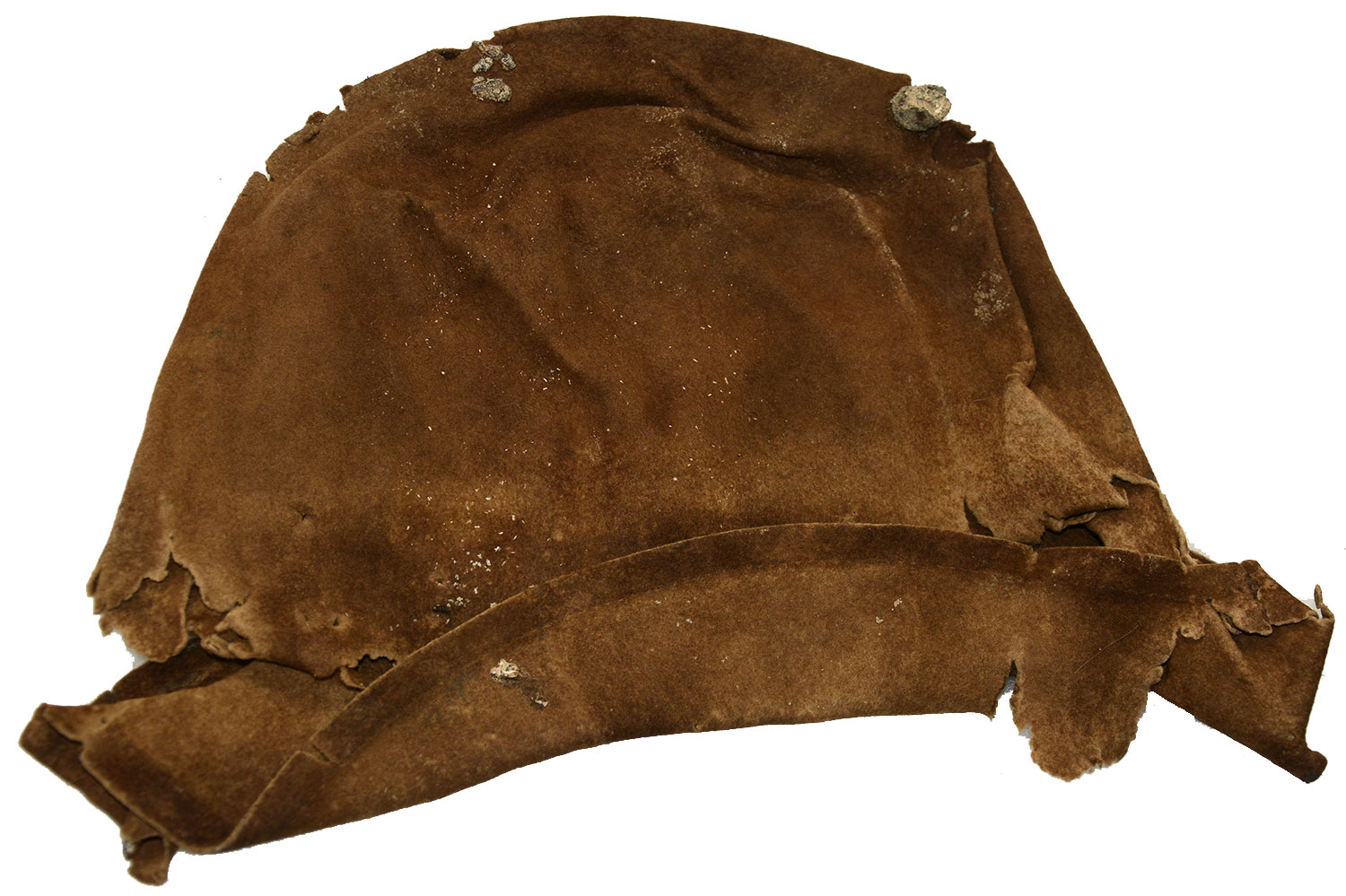site search
online catalog
INDIAN WAR FIELD-USED CAMPAIGN HAT FROM FORT PEMBINA, NORTH DAKOTA

Hover to zoom




$1,695.00
Quantity Available: 1
Item Code: 1052-253
Shipping: Determined by Method & Location of buyer
To Order:
Call 717-334-0347,
Fax 717-334-5016, or E-mail
This is a real field-used Indian War campaign hat in relic condition excavated at Fort Pembina, ND, a small frontier army post in operation from 1870 to 1895. Anaerobic conditions of the dig have produced cloth and leather gear in various states of condition showing the typical postwar army mix of Civil War issue material being used well into the 1870s, along with later army experimental and issue patterns, and private purchase, commercial material used to keep within a soldier’s clothing allowance, because it was better quality, more comfortable, or all three.
This has holes and tears, and has shifted in color to a light brown from what was likely black, but is clearly a slouch hat, likely worn with the top creased and having a brim with a bound edge, showing by a slightly darker color and some preserved black threads that may have been part of a grosgrain ribbon binding. There are some scattered small white stains, but the fabric is solid and it could be blocked out with some care to give a better impression of its shape.
The army did not get around to designing a campaign hat until 1872. Until that point they were either privately purchased or alterations of the army dress hat (the “Hardee hat.”) In any case, the M1872, with its very wide brim and sometimes shapeless appearance, was so disliked that most troops fell back on the Civil War tradition of wearing a privately purchased slouch hat or an issue Hardee hat modified for comfort and convenience on campaign. It was not until 1876 that the army tried again with a new design and not until 1884 that they finally went with a drab color rather than black, something that was certainly cooler to wear. In the meantime it was still worth it to soldiers to use up a cheaper hat on campaign or fatigue duty to avoid exceeding their clothing allowance and having to pay for a new government issue one. See Paul Hedren’s commentary on headgear shown in Stanley Morrow’s photographs of Crook’s 1876 Black Hills Expedition and Doug McChristian’s excellent studies of army dress and gear of the 1870s-80s.
Fort Pembina, situated in the Red River Valley in North Dakota near the Canadian border, was established in 1870 and in operation until 1895. Trading posts existed earlier in the area as part of the fur trade, and the first U.S. military post there was temporary- manned by a detachment of Minnesota troops in 1863-1864 following the 1862 Sioux uprising. In March 1870 a new fort was established south of the Pembina River and about 200 yards west of the Red River, completed by July and named in honor of Gen. George H. Thomas. The name was changed to Fort Pembina in September and the initial garrison consisted of two companies of the 20th US Infantry. Their main duty was to provide security for settlers worried about Sioux returning south from Canada, but the troops were more occupied with escorting boundary surveys along the Canadian border and preventing Fenian raids heading north into Canada.
The fort included enlistedmen’s barracks, officers’ quarters, guard house, ordnance storehouse, company kitchen, root house, laundress’s quarters, quarters for civilian employees, hospital and hospital servant’s house, a barn for the “hospital cow,” quartermaster and commissary offices and storehouse, stables, wagon shed, etc. The garrison reached peak strength in 1878 af 200, but the average was about 125 enlisted men and 8 officers. An October 1885 return listed 97 men, 2 field pieces, 1 mountain howitzer, 100 rifles, 19 pistols, 23 mules, and 9 wagons. By 1890 the post had just 23 men, and after an 1895 fire destroyed some 19 buildings it was decided to abandon the fort rather than rebuild, the last detachment left in September. The property was turned over to the Interior Department and later sold in 1902.
Indian War campaign hats, like their Civil War predecessors, are very scarce. They were meant field use and were not subject to the same care and maintenance as a dress hat or helmet that would be worn at dress parades and inspections. They were also cheap enough to be discarded when worn out and hardly the thing to be preserved by a veteran of his family as a memento. [sr][ph:L]
~~~~~~~~~~~~~~~~~~~~~~~~~~~~~~~~~~~
THIS ITEM, AS WITH ALL OTHER ITEMS AVAILABLE ON OUR WEB SITE,
MAY BE PURCHASED THROUGH OUR LAYAWAY PROGRAM.
CLICK HERE FOR OUR POLICIES AND TERMS.
THANK YOU!
Inquire About INDIAN WAR FIELD-USED CAMPAIGN HAT FROM FORT PEMBINA, NORTH DAKOTA
Most Popular
Historical Firearms Stolen From The National Civil War Museum In Harrisburg, Pa »
Theft From Gravesite Of Gen. John Reynolds »
Selection Of Unframed Prints By Don Troiani »
Fine Condition Brass Infantry Bugle Insignia »
Large English Bowie Knife With Sheath 1870’S – 1880’S »
Imported (Clauberg) Us Model 1860 Light Cavalry Officer's Saber »
featured item
RARE CONFEDERATE “THREE SQUARE” SOCKET BAYONET
This is an excavated example of a Confederate-made musket socket bayonet. Measuring 21” overall with a 2.75” socket. This was made for an early .69 caliber musket with a bayonet lug mounted on the bottom of the barrel; as the bridge is on the… (2022-459). Learn More »


